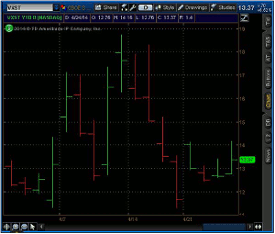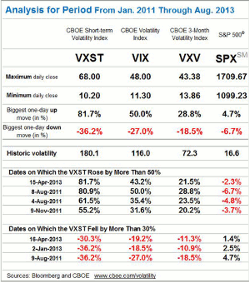The CBOE’s Short-Term Volatility Index might be one of the most under-appreciated trading vehicles, says Steve Smith of Minyanville.com.
Launching investment products during market declines is usually a bad idea—unless you're selling volatility.
The Chicago Board Options Exchange (CBOE) began listing options on the CBOE Short-Term Volatility Index (VXST) on April 10. That turned out to be a great time for VXST to show its value as a volatility play.
During the first two days options were available, the S&P 500 (SPX) tumbled 3.2%, the VIX (VIX) popped 28%, and VXST soared a whopping 40%.
Here is a daily chart from April that shows just how fast VXST can move:
That type of action seems like it would draw serious interest, but trading in VXST futures and options has been surprisingly lackluster, with just a few hundred contracts moving per day.
One issue may simply be that traders need time to understand the products, especially if they're already using the better-known VIX options.
The field may also be too crowded.
The VXST is the third volatility index based on the S&P 500. In turn, they have spawned a host of volatility-related products, including futures, ETNs like iPath S&P 500 VIX Short-Term Futures ETN (VXX), and inverse and leveraged vehicles. And all these products have listed options.
Whatever the case may be, I hope VXST gains traction as it may be the best way to trade volatility.
Normally, I am extremely wary of volatility-related vehicles as they come with a variety of quirks. But the VXST may provide the closest approximation for trading real-time volatility of the S&P 500.
The VXST Index is based on the weighted prices of options on the S&P 500 Index with an average of nine days until expiration. It is designed to reflect investors' consensus of near-term (nine-day) expected stock market volatility.
That structure makes VXST a more appropriate gauge to measure volatility expectations for weekly options, which now account for over 25% of all option volumes. Weekly options are especially active in volatile momentum stocks like Netflix (NFLX), Google (GOOG), and Amazon (AAPL) during earnings season.
The VXX has not worked well as a long-term hedge because of a downside headwind from the constant futures contract roll as well as the nature of volatility to revert to the mean. VXST allows for trading near-term volatility, which is what traders really focus on.
Trying to predict where volatility will be in three or six months is a fool's errand, and buying a contract out that far is akin to picking up a lottery ticket.
Let's take a look at how VXST can be deployed in a real-life situation, but first, let's run down some pertinent points:
NEXT PAGE: Steve’s Suggested Volatility Plays
|pagebreak|Currently there are four active futures contracts and related options for up to 12 expiration weeks. Just like the current VIX futures and options, everything is cash-settled on Wednesday. Note: This means that the underlying security is the futures, not the Index itself. This means that even though each contract is focused on a nine-day window, there will be issues of skew and potential backwardation across the different expirations.
The volatility of this volatility index will be extremely high. As noted above, on the recent decline, the VXST surged some 40% while the VIX popped a lesser 28%. The options tied to VXST reflect this greater sensitivity. The implied volatility of VXST's first-week options jumped to 110% last week but are now down to the 65% level. This compares to the IV of VIX options, which jumped to 75% and are now 55%.
You can find all the contract specifications and historical data on the CBOE site.
Here is a comparison of price moves and volatility levels for various VIX Indices and the S&P 500 Index over a 2.5-year period as calculated by Bloomberg:
What is not shown is that VXST has jumped more than 40% in a single day on seven occasions since February 2011. This high "volatility of volatility" nature, plus negative correlation to broader markets, makes it a very intriguing trading and hedging tool.
The most straightforward way to use VXST options would be to simply buy calls in anticipation of a jump in volatility that might result from a market decline.
While both Apple (AAPL) and Facebook (FB) delivered positive earnings and carried the market higher on Thursday, if they had disappointed, the market would have likely sold off.
Buying VXST calls would have been a good, low-cost way to gain downside protection compared to buying put options on those names or an index.
Even with the market higher Thursday, the VXST was actually up 5%, meaning the calls held their value.
With tensions mounting in Ukraine and traders anticipating the upcoming FOMC meeting, it might make sense to own some VXST calls for this week.
Another approach might be to wait for a sharp spike in volatility and then sell calls or buy puts that have one to two weeks until expiration on the notion that the volatility lift will be short-lived.
Advanced traders may want to look at arbitrage opportunities between the VXST and VIX options. My first instinct would be to buy the VXST calls and sell VIX calls on the notion that the VXST will outperform on any lift in volatility. But I'd like to see how these trade for a little longer before endeavoring to do that.
The VIX futures and options have proved to be wildly successful product in terms of volume with hundreds of contracts trading daily. I hope the VXST follows suit.
By Steve Smith, Contributor, Minyanville.com























